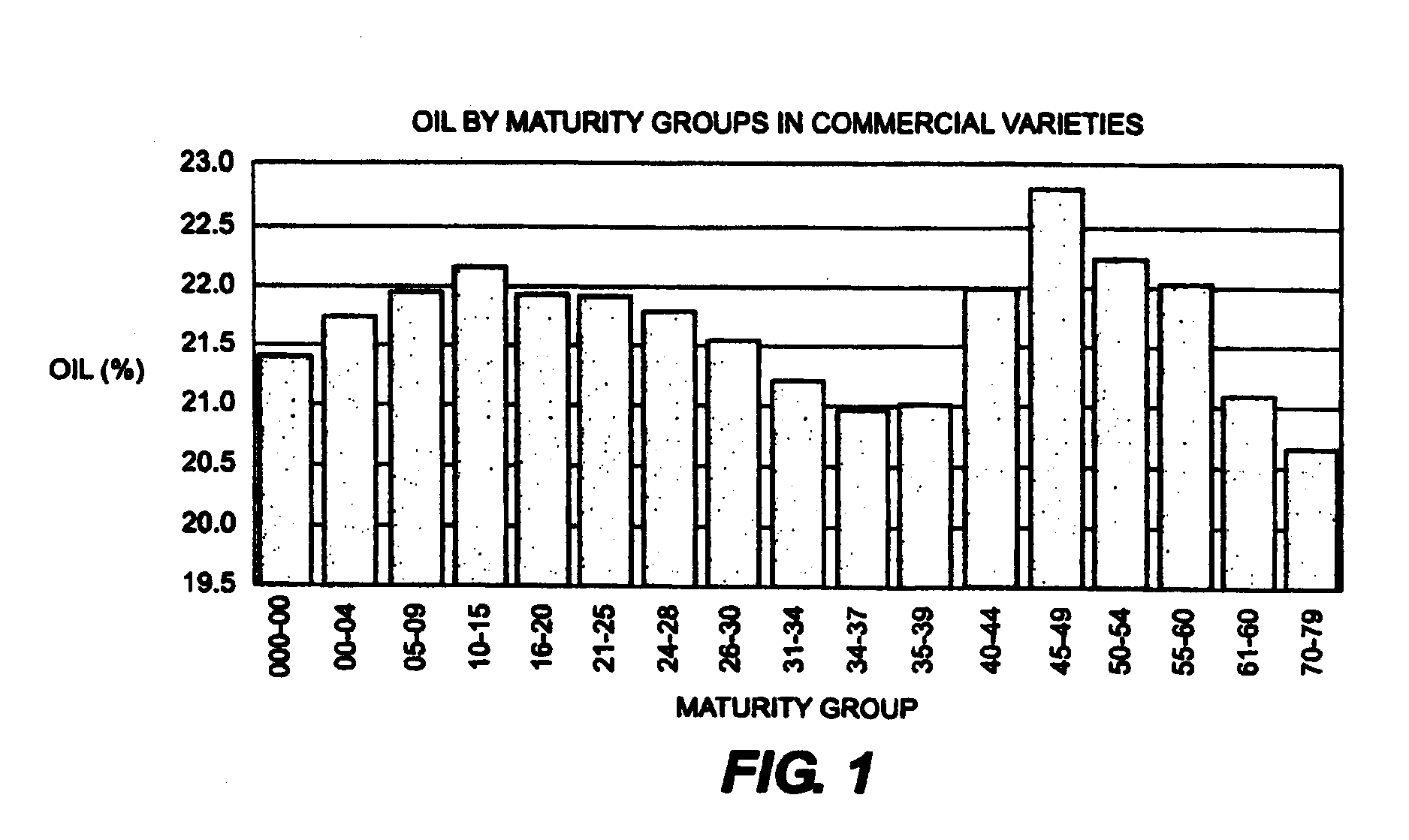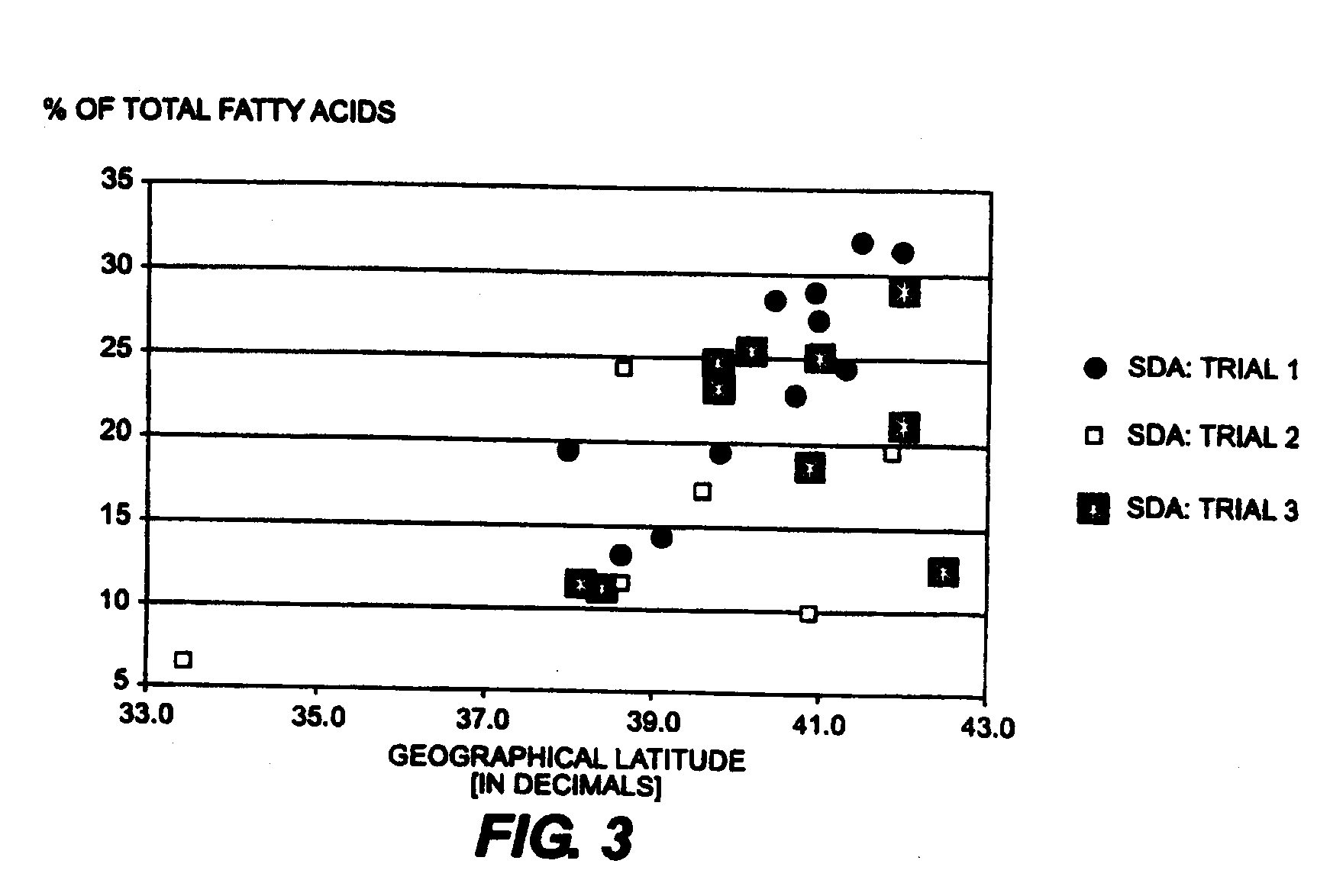Utility of SNP markers associated with major soybean plant maturity and growth habit genomic regions
a technology of genome regions and snp markers, which is applied in the identification of library members, biochemistry apparatus and processes, microbiological testing/measurement, etc., can solve the problems of accelerated flowering, inaccessible specimens of many exotic species, and cost prohibitive practice, so as to improve yield, high oil production, and the effect of modifying the oil production
- Summary
- Abstract
- Description
- Claims
- Application Information
AI Technical Summary
Benefits of technology
Problems solved by technology
Method used
Image
Examples
example 1
Discovery of Molecular Markers Associated with Genomic Regions Affecting Plant Maturity
[0501]Soybean is a short day plant, therefore flowering is initiated by short days due to a decrease in photoperiod (Garner & Allard, J. Agric. Res. 18, 553-606 (1920)). Consequently, photoperiod (day length) and temperature response of the soybean plant determines areas of plant adaptation. Due to photoperiod sensitivity, soybean genotypes are grown to narrow zones of latitude to optimize yield. Northern soybean varieties, in contrast to Southern varieties, initiate flowering with longer days. Northern varieties planted south of their adaptation zone exhibit accelerated flowering, limited plant growth and reduced yield. Southern soybean varieties planted north of their adaptation zone will have delayed flowering with a potential for frost damage that may reduce yield. Most soybean variety development crosses are made between parents within 10 maturity days of each other. If the parents differ gre...
example 2
Identifying Allelic Combinations of Genomic Regions Associated with Plant Maturity in Early Maturity Group Soybeans
[0513]Genomic regions 1 and 2 are used to predict the plant maturity of progeny plant resulting from a cross between early maturity and mid-maturity parents (III-V). In particular, the allelic combinations of genomic regions 1 and 2 are correlated with a delay in plant maturity. To determine the correlation between allelic combinations of region 1 and 2 and delay in plant maturity, three populations are developed from crossing an early maturity parent (maturity group 00) with a mid-maturity parent (maturity group III or IV) (Table 6). Populations 1-3 are used to determine the association of the composition of genomic regions 1 and 2 with delay in plant maturity.
TABLE 6Maturity group phenotype of parents in soybean populationsMaturityMaturityGroup ofGroup ofFemaleFemalePopulationParentParent100.93.1200.93.4300.94.145.94.755.95.165.84.774.100.983.100.993.400.9
[0514]The th...
example 3
Identifying Allelic Combinations of Genomic Regions Associated with Plant Maturity in Late Maturity Group Soybeans
[0515]Genomic regions 1, 2, and 3 are used to predict the plant maturity of progeny plant resulting from a cross between late maturity and mid-maturity parents. In particular, some of the allelic combinations of genomic regions 1, 2 and 3 are correlated with a delay in plant maturity (Table 8 and 9). To determine the correlation between allelic combinations of region 1, 2 and 3 and delay in plant maturity, three F3 populations are developed from crossing a late maturity group V with a late maturity group IV. The populations 4-6 following crosses are used to determine the association of the composition of genomic regions 1, 2 and 3 with delay in plant maturity.
[0516]The three segregate widely for maturity and are polymorphic at genomic regions 1, 2, and 3. F3 seed are obtained by selecting one seed per F2 plant (single seed descent). 5,984 F3 individuals from all three po...
PUM
| Property | Measurement | Unit |
|---|---|---|
| temperature | aaaaa | aaaaa |
| temperature | aaaaa | aaaaa |
| temperature | aaaaa | aaaaa |
Abstract
Description
Claims
Application Information
 Login to View More
Login to View More - R&D
- Intellectual Property
- Life Sciences
- Materials
- Tech Scout
- Unparalleled Data Quality
- Higher Quality Content
- 60% Fewer Hallucinations
Browse by: Latest US Patents, China's latest patents, Technical Efficacy Thesaurus, Application Domain, Technology Topic, Popular Technical Reports.
© 2025 PatSnap. All rights reserved.Legal|Privacy policy|Modern Slavery Act Transparency Statement|Sitemap|About US| Contact US: help@patsnap.com



